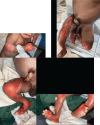Aplasia cutis congenita of extremities (group VII): case report from North-Western Nigeria
- PMID: 38380406
- PMCID: PMC10876273
- DOI: 10.24911/SJP.106-1670856184
Aplasia cutis congenita of extremities (group VII): case report from North-Western Nigeria
Abstract
Aplasia cutis congenita (ACC) is a rare congenital disorder characterised by localised or widespread absence of skin mainly affecting the scalp. Bilateral involvement of both the upper and lower extremities is uncommon. This is a case report of a rare congenital disorder. The patient was a 26-hour-old male baby admitted with extensive absence of skin on the lower and upper extremities. He was co-managed conservatively with the plastic surgical team for ACC group VII. The lesions were healing satisfactorily until 12 days into the admission when the parents signed against medical advice despite counselling. ACC with involvement of both upper and lower extremities is a rare presentation that responds to conservative treatment. The report emphasises the need for a legal framework for physicians to override the decision of the caregiver not in the best interest of a child.
Keywords: Aplasia cutis congenital; Extremities; Group VII; Nigeria.
Copyright © Sudanese Association of Pediatricians.
Conflict of interest statement
The authors declare no conflict of interest.
Figures
References
-
- Browning JC. Aplasia cutis congenita: approach to evaluation and management. Dermatol Ther. 2013;26(6):439–44. https://doi.org/10.1111/dth.12106. - PubMed
-
- AlShehri W, AlFadil S, AlOthri A, Alabdulkarim AO, Wani SA, Rabah SM. Aplasia cutis congenita of the scalp with a familial pattern. Case Rep Surg. 2016;2016:4264721. https://doi.org/10.1155/2016/4264721. - PMC - PubMed
-
- Frieden IJ. Aplasia cutis congenita: a clinical review and proposal for classification. J Am Acad Dermatol. 1986 Apr;14(4):646–60. https://doi.org/10.1016/S0190-9622(86)70082-0. - PubMed
-
- Schierz IA, Giuffrè M, Del Vecchio A, Antona V, Corsello G, Piro E. Recognizable neonatal clinical features of aplasia cutis congenita. Ital J Pediatr. 2020 Feb;46(1):25. https://doi.org/10.1186/s13052-020-0789-5. - PMC - PubMed
-
- Cordon M. Extrait d’une letter au sujet de trios enfants de la meme nes avee partie des extremities denuee de peau. J Med Chir Pharmacie. 1767;26:556–7.
Publication types
LinkOut - more resources
Full Text Sources

